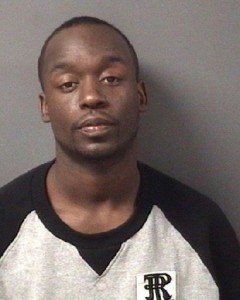Marquis Skillman knew Hykeem Tucker by the nickname “Tex.”
When it is spelled another way, it can refer to a TEC-9 handgun.

Hykeem Tucker
So it was peculiar when a firearms expert testified Thursday he believes Carl Batie’s killer used a TEC-9 to shoot him in the head Nov. 11, 2012, while he stood on the balcony of the Baldassari Regency banquet hall in Trenton.
Graphic testimony from a medical examiner about how the Mercer County corrections officer died was wrapped around the firearms expert’s opinion about the handgun used to shoot Batie. It also hinted at potential surprises in closing arguments.
Testimony from Detective Sgt. Christopher Clayton of the New Jersey State Police appeared to leave the door open for prosecutors to argue there may have been two shooters.
But any surprises were quickly dispelled by prosecutors as Judge Andrew Smithson considers a directed verdict after defense attorneys argued prosecutors failed to prove their case. He is expected to announce his decision Friday.
Meanwhile, suspected killers Maurice Skillman and Tucker are contemplating whether they will testify if and when the trial resumes next week. Prosecutors rested their case after calling 17 witnesses, including Batie’s brother, Karshawn, and lead investigator Scott Peterson.
Clayton’s testimony about ballistics tests he performed on shell casings grabbed the attention of defense attorney who inferred his results left open the possibility prosecutors could claim there were two shooters.

Maurice Skillman
Prosecutors quickly rejected that and maintained they believe Maurice Skillman, Tucker’s co-defendant, is the lone gunman. Tucker was charged under “accomplice liability” laws and denied in an interrogation shown to jurors that he opened fire the night Batie was killed.
No handgun connecting either suspect was recovered.
As a result, Clayton worked backwards to try to identify the handgun prosecutors believe Maurice Skillman used. His testimony was also critical to show jurors all rounds were fired by a single gunman, prosecutors said.
To that end, Clayton testified he examined 22 spent shell casings and three bullet fragments investigators collected from the banquet hall.
After using a microscope to look at the shell casings and striation patterns left from a firing pin, Clayton concluded 19 rounds were fired from the same unknown gun.
Three of the shell casings – exhibits S42, S46 and S47 – also appeared to have been fired from the same gun but Clayton said on cross examination he couldn’t say so with “sufficient agreement.”
The next step was figuring out the type of weapon likely used to fire the rounds, Clayton said. He sorted through “class and individual” characteristics of marks left on rounds in evidence and said they were similar to ones from the firing pin of a TEC-9, which shoots in rapid succession.

Carl Batie
Witnesses testified earlier in the trial they heard as many as 20 gun shots in a short burst. Prosecutors believe the shots were fired in about six seconds.
Clayton found a TEC-9 in a collection of more than 2,000 weapons State Police seized from investigations. He went to a firing range and concluded it is capable of letting off 22 rounds in six seconds.
Jurors were shown a photo of a TEC-9, a handgun that resembles a shortened machine gun. It has an extended capacity clip that can be used as a second grip.
Smithson warned jurors the picture was an example of a TEC-9 and did not depict the actual TEC-9 prosecutors believed was used to kill Batie.
Jason Charles Matey, Skillman’s attorney, asked Clayton whether he fired other weapons. Clayton did not.
Clayton disputed a suggestion from Matey his findings were a “guess.”
Mercer County medical examiner Dr. Raafat Ahmad, who performed an autopsy on Batie, testified he was killed by a single bullet.
Batie’s family members grew emotional when Ahmad noted the corrections officer was otherwise healthy.
The bullet was lodged in Batie’s head and Ahmad, the state’s final witness, concluded his manner of death as a homicide. Jurors did not see autopsy photos of his injuries.
Jurors could begin deliberating the case as early as Tuesday, the judge said, after they heard from lay and expert witnesses. Their verdict will largely depend on interpretation and observations of surveillance tapes narrated over by Peterson, the lead detective.
Peterson testified he positively identified Maurice Skillman as the shooter, and he identified Tucker because of a distinctive varsity jacket he wore and with help from a FBI special agent’s confidential informant.
Peterson said a taller black man he identified as Skillman is seen on surveillance opening fire on the balcony. Peterson used a laser pointer to focus jurors’ attention on the man he says raised his arm moments before a flash of gunfire, which is hard to see on the tape.
Nicole Carlo, Skillman’s attorney, said her client was wrongfully accused. She put on a third-party guilt defense, implicating Shaquel Rock, an alleged Bloods gang member, and his associates.
Rock was arrested the night Batie was killed after he threatened an off-duty police officer working security detail at the door.
Peterson said he eliminated Rock as a suspect because he didn’t match a physical description of the shooter. Rock was shorter and wore a white hoodie.
The shooter was potentially wearing a gray hoodie, according to testimony.
Carlo seized on another suspect description provided to Peterson of two individuals wearing white and blue hoodies fleeing the scene. Investigators later searched a vehicle belonging to Edgar Williams, Rock’s cousin, and found sweaters and a varsity jacket.
Both sides have quibbled if it was the same varsity jacket worn by Tucker.
Peterson testified Tucker’s varsity jacket had a circular decal on the right arm, which is different from the blue Champion varsity jacket seized from Williams’ vehicle.
The jacket was shown to jurors at trial, which resumes Monday morning.